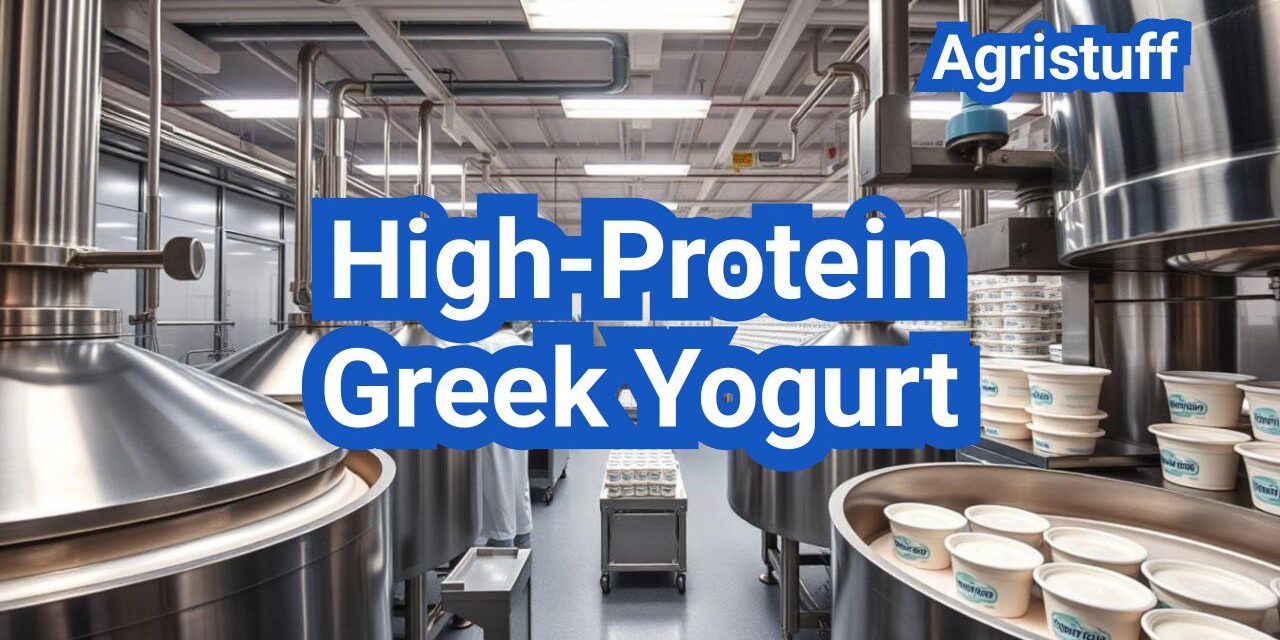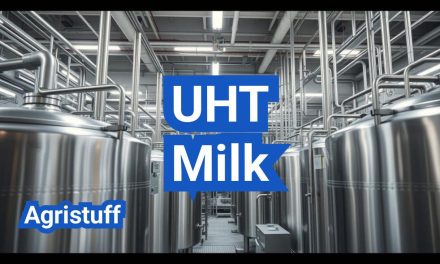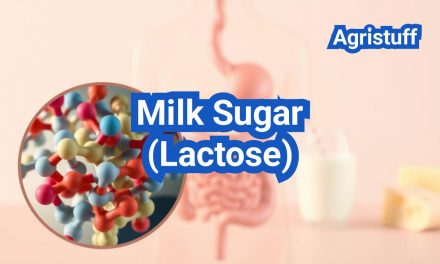This article does not contain medical advice
High-protein Greek yogurt has gained immense popularity among health-conscious consumers due to its thick texture and rich nutritional profile. Unlike regular yogurt, Greek yogurt is strained more, removing excess liquid whey, making it higher in protein. This processing technique not only enhances its texture but also boosts its nutritional value.
The benefits of consuming high-protein Greek yogurt are numerous, ranging from supporting muscle health to aiding in weight management. As consumers become more aware of their dietary choices, the demand for protein-rich foods like Greek yogurt continues to grow.
Key Takeaways
- High-protein Greek yogurt is made by straining more whey than regular yogurt.
- It’s a popular choice among health-conscious consumers due to its high protein content.
- The processing of Greek yogurt enhances its nutritional profile.
- Consuming high-protein Greek yogurt can support muscle health and weight management.
- It’s a versatile ingredient that can be used in various recipes.
What Is High-Protein Greek Yogurt?
Understanding what constitutes high-protein Greek yogurt is essential for making informed dietary choices. High-protein Greek yogurt is a type of yogurt that has gained popularity for its thick texture and nutritional benefits.
The Definition and Origin of Greek Yogurt
Greek yogurt is made by straining whey from yogurt, resulting in a thicker consistency. This process, known as straining, removes excess liquid, leaving behind a more concentrated product that is rich in protein. The origin of Greek yogurt dates back to ancient Greece, where it was consumed for its health benefits.
Traditional Production Method: Traditionally, Greek yogurt is made by straining yogurt through a cheesecloth or a fine mesh, which removes the whey and concentrates the protein.
What Makes Greek Yogurt “High-Protein”
The straining process is what makes Greek yogurt “high-protein.” By removing excess liquid, the protein content becomes more concentrated. Most commercial high-protein Greek yogurts contain between 15 to 20 grams of protein per serving.
| Type of Yogurt | Protein Content (per serving) |
|---|---|
| Regular Yogurt | 5-10 grams |
| Greek Yogurt | 15-20 grams |
In summary, high-protein Greek yogurt is defined by its straining process and high protein content, making it a popular choice among health enthusiasts.
The Science Behind High-Protein Greek Yogurt Processing

Understanding how high-protein Greek yogurt is made requires a look into both traditional and modern manufacturing processes. The production of Greek yogurt, particularly the high-protein variety, involves a straining process that removes excess whey, resulting in a thicker, creamier yogurt with a higher protein content.
Traditional Greek Yogurt Production Methods
Traditionally, Greek yogurt is made by straining yogurt through a cheesecloth or a fine mesh sieve. This labor-intensive process allows for the removal of whey, concentrating the protein and giving the yogurt its characteristic thickness. The traditional method is still used today in some small-scale productions, preserving the authentic texture and taste of Greek yogurt.
Traditional straining methods not only affect the texture but also influence the flavor profile, as the longer straining time can result in a tangier taste. This method, while time-consuming, produces a high-quality yogurt that is rich in protein and has a distinct taste.
Modern Manufacturing Techniques
Modern manufacturing techniques have revolutionized the production of high-protein Greek yogurt. Instead of cheesecloth, manufacturers use centrifuges or ultrafiltration systems to strain the yogurt. These machines can process large quantities quickly and efficiently, making high-protein Greek yogurt more accessible to a wider audience.
The use of modern machinery allows for a more consistent product in terms of texture and protein content. Additionally, some manufacturers may add protein concentrates or isolates to further boost the protein content of their yogurt. This combination of traditional straining principles with modern technology has enabled the mass production of high-protein Greek yogurt.
By understanding both the traditional and modern methods of Greek yogurt production, consumers can appreciate the craftsmanship and technology that goes into creating this popular dairy product.
Greek Yogurt vs. Regular Yogurt: Key Differences
When comparing Greek yogurt to regular yogurt, several key differences emerge that can impact your dietary choices. The primary distinctions lie in their processing methods, protein content, texture, and overall nutritional profile.
Protein Content Comparison
One of the most significant differences between Greek yogurt and regular yogurt is their protein content. Greek yogurt is known for its high protein content due to the straining process it undergoes, which removes excess liquid and concentrates the protein. For instance, a 6-ounce serving of Greek yogurt can contain between 15 to 20 grams of protein, whereas the same serving size of regular yogurt typically contains around 9 grams. As noted by a nutrition expert, “High-protein diets can help with satiety and muscle recovery,” making Greek yogurt a popular choice among fitness enthusiasts and health-conscious individuals.
Texture and Taste Differences
The straining process that Greek yogurt undergoes not only increases its protein content but also gives it a thicker, creamier texture compared to regular yogurt. Regular yogurt, on the other hand, has a thinner consistency and may contain more sugar. The taste difference is also notable, with Greek yogurt often described as having a tangier, more pronounced flavor. As a consumer review states, “I prefer Greek yogurt for its rich texture and less watery consistency.”
Nutritional Profile Comparison
Beyond protein content and texture, Greek yogurt and regular yogurt also differ in their nutritional profiles. Greek yogurt generally contains fewer carbohydrates and less sugar than regular yogurt, although this can vary depending on the brand and any added flavorings. Additionally, Greek yogurt tends to have a higher concentration of calcium, which is crucial for bone health. A comparison of the nutritional labels of popular brands reveals that Greek yogurt often has a more favorable nutrient profile, with “less sugar and more calcium.”
Nutritional Benefits of High-Protein Greek Yogurt

High-protein Greek yogurt is a nutritional powerhouse, offering numerous health benefits that make it an excellent addition to a balanced diet. Its impressive nutritional profile supports overall health and wellbeing in various ways.
Complete Protein Profile
One of the key nutritional benefits of high-protein Greek yogurt is its complete protein profile. It contains all nine essential amino acids that the body cannot produce on its own, making it an excellent source of protein for muscle repair and growth. A complete protein is particularly beneficial for individuals looking to support muscle health or manage weight.
Calcium and Vitamin D Content
High-protein Greek yogurt is also rich in calcium and vitamin D, two nutrients that are crucial for bone health. Calcium supports bone density, while vitamin D enhances calcium absorption, promoting strong bones and teeth. Regular consumption can help maintain bone health and reduce the risk of osteoporosis.
Probiotics and Gut Health
The probiotics in high-protein Greek yogurt play a significant role in supporting gut health. Probiotics are live bacteria and yeasts that are beneficial for the digestive system. They help maintain a healthy gut microbiome, supporting digestion and boosting the immune system. A healthy gut microbiome is linked to various health benefits, including improved mental health and reduced inflammation.
Incorporating high-protein Greek yogurt into your diet can have a positive impact on your overall health, thanks to its rich nutritional profile and the benefits of its probiotics, calcium, and vitamin D.
Understanding High Protein Greek Yogurt Labels
Deciphering the labels on high-protein Greek yogurt products can seem daunting, but it’s a crucial step in selecting the right yogurt for your dietary needs. With various brands and types available, understanding what’s on the label is key to making an informed decision.
Average Protein Content by Serving Size
The protein content in Greek yogurt is a primary concern for many consumers. Serving sizes can vary significantly, affecting the total protein intake. Typically, a 6-ounce serving of high-protein Greek yogurt contains between 15 to 20 grams of protein. However, it’s essential to check the label as serving sizes and protein content can differ between brands.
For instance, some brands may offer larger or smaller containers, and the protein content per serving can range from 10 to 25 grams or more per serving. Being aware of the serving size helps in accurately calculating your protein intake.
Factors Affecting Protein Content
Several factors can influence the protein content in Greek yogurt. Processing methods play a significant role; traditional straining methods can result in higher protein content compared to some modern manufacturing processes. Additionally, some brands may add protein powders or other protein-rich ingredients to boost the protein content.
The type of milk used (non-fat, low-fat, or whole) can also impact the nutritional profile, including protein content. Furthermore, flavorings and sweeteners can affect the overall nutritional value, making it crucial to check the ingredients list alongside the nutrition facts.
Top High-Protein Greek Yogurt Brands in the U.S.
When it comes to high-protein Greek yogurt, the U.S. market is dominated by a few key players. Brands like Chobani, Fage, and Oikos have gained popularity for their high-protein content and quality products.
Chobani Protein
Chobani’s Protein line offers between 15-20 grams of protein per serving. Known for its creamy texture and wide range of flavors, Chobani has become a favorite among Greek yogurt enthusiasts. The brand uses non-GMO ingredients and offers a variety of options to cater to different tastes.
Fage Total
Fage Total is another high-protein Greek yogurt brand that stands out in the U.S. market. It boasts an impressive 20 grams of protein per serving. Fage is known for its thick and creamy texture, achieved through a straining process that removes excess whey. The brand offers various fat content options, from non-fat to full-fat.
Oikos High Protein
Oikos, a Danone brand, offers a high-protein Greek yogurt line with 11-16 grams of protein per serving. Oikos is recognized for its smooth texture and delicious flavors. The brand also offers a range of products, including Oikos Triple Zero, which contains zero added sugars, zero artificial flavors, and zero artificial sweeteners.
Other Notable Brands
While Chobani, Fage, and Oikos are among the most popular, other brands are also worth mentioning. Brands like Siggi’s, Dannon Greek Yogurt, and Yoplait Greek offer high-protein options with unique features. Siggi’s, for example, is known for its Icelandic-style yogurt with high protein and low sugar content.
| Brand | Protein Content (per serving) | Notable Features |
|---|---|---|
| Chobani Protein | 15-20g | Non-GMO, various flavors |
| Fage Total | 20g | Thick and creamy texture, various fat content options |
| Oikos High Protein | 11-16g | Smooth texture, Triple Zero option with no added sugars |
| Siggi’s | 17-20g | Icelandic-style, high protein, low sugar |
How to Choose the Best High-Protein Greek Yogurt
With numerous options available, selecting the ideal high-protein Greek yogurt requires careful consideration. The key to making an informed decision lies in understanding the various factors that differentiate one product from another.
Reading Nutrition Labels
When choosing Greek yogurt, it’s essential to read the nutrition label carefully. Look for the protein content per serving size, as this can vary significantly between brands. A higher protein content is often desirable, especially for those looking to support muscle growth or weight management.
Check the label for added sugars, as many flavored yogurts can be high in sugar. Opt for unflavored or lightly flavored varieties to keep sugar intake in check. Additionally, consider the calorie count to ensure it aligns with your dietary needs.
Understanding Ingredients Lists
The ingredients list can provide valuable insights into the quality of the yogurt. Look for products with simple, natural ingredients. Avoid yogurts with artificial flavors, colors, or preservatives. Some brands may include additional ingredients like probiotics or thickeners, which can be beneficial depending on your needs.
Be aware of the order of ingredients, as they are listed by quantity. If sugar is one of the first ingredients, it may indicate a higher sugar content. Conversely, if protein or milk is listed first, it’s likely a higher protein product.
Organic vs. Conventional Options
The debate between organic and conventional Greek yogurt largely revolves around the production methods and potential pesticide residues. Organic yogurt is produced without synthetic pesticides or fertilizers, which may appeal to those seeking to minimize their exposure to chemicals.
Conventional yogurt, on the other hand, may be more affordable and still offer high protein content and quality. Ultimately, the choice between organic and conventional depends on personal preference and budget. Consider your priorities when deciding which option is best for you.
Low Sugar High-Protein Greek Yogurt Options

With the rising awareness of the importance of reducing sugar intake, low sugar high-protein Greek yogurt has become a sought-after dairy product. Consumers are increasingly looking for yogurt options that are not only high in protein but also low in sugar, making it a challenge for manufacturers to balance these requirements without compromising on taste.
Why Sugar Content Matters
High sugar content in yogurt can be a significant deterrent for health-conscious consumers. Excessive sugar consumption has been linked to various health issues, including obesity and diabetes. Therefore, understanding the sugar content in Greek yogurt is crucial for making informed dietary choices. Low sugar Greek yogurt options are becoming increasingly popular as consumers seek to minimize their sugar intake without sacrificing the nutritional benefits of yogurt.
Top Low-Sugar Brands
Several brands have responded to the demand for low sugar Greek yogurt by offering products with reduced sugar content. Some of the top brands include:
- Chobani Non-Fat Greek Yogurt with Less Sugar
- Fage Total 0% with Less Sugar
- Oikos Triple Zero Greek Yogurt
These brands use various methods to reduce sugar content, including the use of natural sweeteners and careful management of the straining process to minimize lactose content.
Natural vs. Artificial Sweeteners
The use of sweeteners in low sugar Greek yogurt is a critical consideration. Natural sweeteners like stevia and monk fruit are preferred by many consumers over artificial sweeteners due to their perceived health benefits and lower risk of side effects. However, some brands still use artificial sweeteners like sucralose and aspartame to achieve the desired taste with minimal calories. Consumers should be aware of the type of sweetener used in their chosen yogurt to make informed decisions that align with their dietary preferences and needs.
Specialty High-Protein Greek Yogurts

Specialty high-protein Greek yogurts have emerged, offering lactose-free, plant-based, and other cultured dairy products that cater to diverse dietary needs and preferences. These innovative products ensure that consumers with specific dietary requirements or restrictions can also benefit from the high-protein, nutritious profile of Greek yogurt.
Lactose-Free Options
Lactose-free high-protein Greek yogurts are designed for individuals with lactose intolerance, providing the same nutritional benefits without the discomfort. Brands achieve this by adding lactase, the enzyme that breaks down lactose, making these yogurts easily digestible.
Plant-Based Alternatives
Plant-based high-protein Greek yogurts are made from various sources such as almond milk, soy milk, or coconut milk, offering a dairy-free alternative. These yogurts are ideal for vegans or those with dairy allergies, and they often contain protein-rich ingredients like pea protein or rice protein.
Kefir and Other Cultured Dairy Products
Kefir, a type of cultured dairy product, is similar to yogurt but has a thinner consistency and a wider variety of beneficial probiotic bacteria. High-protein kefir products are becoming popular for their enhanced nutritional profile and potential digestive health benefits.
| Product Type | Key Features | Target Audience |
|---|---|---|
| Lactose-Free Greek Yogurt | Lactase added, high protein | Lactose intolerant individuals |
| Plant-Based Greek Yogurt | Dairy-free, protein-rich | Vegans, those with dairy allergies |
| High-Protein Kefir | Thin consistency, diverse probiotics | Health-conscious consumers |
Where to Buy High-Protein Greek Yogurt

High-protein Greek yogurt is now a common find in most supermarkets and online stores. This widespread availability makes it easier for consumers to incorporate this nutritious food into their diets.
Major Supermarket Options
Major supermarket chains carry a variety of high-protein Greek yogurt brands. Stores like Aldi, Tesco, Walmart, and Kroger typically have a dedicated yogurt section with multiple high-protein options. These supermarkets often carry well-known brands such as Chobani, Fage, and Oikos, offering a range of flavors and protein content.
| Supermarket | High-Protein Greek Yogurt Brands |
|---|---|
| Aldi | Simply Nature, Friendly Farms |
| Tesco | Own Brand, Chobani |
| Walmart | Great Value, Fage, Oikos |
| Kroger | Simple Truth, Chobani, Fage |
Online Shopping Options
For those who prefer shopping online, high-protein Greek yogurt is available on various e-commerce platforms. Amazon, Walmart.com, and Thrive Market offer a wide selection of brands and flavors. Online shopping provides the convenience of having products delivered directly to your doorstep, often with the option of subscription services for regular deliveries.
High-Protein Greek Yogurt for Health Benefits

The health benefits of high-protein Greek yogurt are multifaceted, ranging from weight management to improved digestive health. This versatile dairy product has become a staple in many health-conscious diets due to its rich nutritional profile.
Weight Management Benefits
High-protein Greek yogurt supports weight management by promoting feelings of fullness and reducing hunger. The protein content helps in maintaining muscle mass while losing weight, ensuring that the weight loss is primarily from fat.
Muscle Recovery and Building
For individuals engaged in regular physical activity, high-protein Greek yogurt is an excellent recovery tool. The protein helps in repairing and building muscle tissue, making it a popular choice among athletes and fitness enthusiasts.
Digestive and Immune System Support
High-protein Greek yogurt contains probiotics, which are beneficial bacteria that support gut health. A healthy gut microbiome is crucial for a strong immune system and efficient digestion, contributing to overall wellbeing.
Incorporating high-protein Greek yogurt into your diet can have a significant positive impact on your health, from managing weight and building muscle to supporting digestive and immune system health.
Making Homemade High-Protein Greek Yogurt

Making homemade high-protein Greek yogurt is a simple process that requires just a few basic ingredients and equipment. By creating your own yogurt, you can control the protein content, sugar levels, and flavor to suit your dietary needs and preferences.
Required Equipment and Ingredients
To make homemade high-protein Greek yogurt, you’ll need a few basic pieces of equipment, including a large pot, a thermometer, and a strainer or cheesecloth. The ingredients required are milk (whole, low-fat, or nonfat), a yogurt starter culture (which contains the bacteria Lactobacillus bulgaricus and Streptococcus thermophilus), and optional flavorings or sweeteners.
Step-by-Step Process
The process of making homemade high-protein Greek yogurt involves several steps:
- Heat the milk to 180°F (82°C) to kill any bacteria that may be present.
- Allow the milk to cool to 110°F (43°C), then add the yogurt starter culture and mix well.
- Incubate the mixture at 100°F (38°C) for 6-8 hours, or until it has thickened and set.
- Chill the yogurt in the refrigerator to stop the incubation process.
- Strain the yogurt through a cheesecloth or a fine-mesh sieve lined with cheesecloth to remove excess liquid and achieve the desired consistency.
Tips for Maximum Protein Content
To maximize the protein content of your homemade Greek yogurt, use high-protein milk or add protein powder to the milk before incubation. You can also strain the yogurt for a longer period to remove more liquid and concentrate the protein.
Tips: Using a high-quality yogurt starter culture and maintaining the correct incubation temperature are crucial for achieving the desired protein content and yogurt texture.
Greek Yogurt Breakfast Ideas

High-protein Greek yogurt is a versatile ingredient that can be used in a variety of delicious breakfast dishes. Incorporating it into your morning meal can provide a boost of protein to keep you energized throughout the day.
Quick and Easy Breakfast Bowls
One of the simplest ways to enjoy Greek yogurt for breakfast is by creating a quick and easy breakfast bowl. Start with a base of high-protein Greek yogurt, then add your favorite toppings such as fresh berries, granola, or sliced banana. You can also add a drizzle of honey or a sprinkle of cinnamon for extra flavor.
Some popular combinations include:
- Blueberry bliss: Greek yogurt, fresh blueberries, and a sprinkle of granola
- Tropical twist: Greek yogurt, diced mango, and toasted coconut flakes
- Nutty delight: Greek yogurt, sliced almonds, and a drizzle of honey
Make-Ahead Breakfast Options
For busy mornings, make-ahead breakfast options are a lifesaver. You can prepare Greek yogurt parfaits or overnight oats the night before and have a healthy breakfast ready to go in the morning.
To make a Greek yogurt parfait, layer Greek yogurt, granola, and fresh fruit in a jar or container. Refrigerate overnight and enjoy in the morning. Alternatively, you can mix together Greek yogurt, rolled oats, and milk in a jar, then refrigerate overnight and top with fresh fruit in the morning.
“Incorporating high-protein Greek yogurt into your breakfast routine can have numerous health benefits, from weight management to improved digestion.”
High-Protein Greek Yogurt Smoothie Recipes
High-protein Greek yogurt is a versatile ingredient that can be blended into a variety of tasty and nutritious smoothies. By combining it with other healthy ingredients, you can create a quick and satisfying snack or meal replacement that supports your fitness and dietary goals.
Basic Smoothie Formula
To make a basic high-protein Greek yogurt smoothie, start with a base of Greek yogurt, then add your choice of liquid, such as milk or juice, and finally incorporate fruits, nuts, or other desired ingredients. A simple formula to follow is:
- 1 cup high-protein Greek yogurt
- 1/2 cup liquid (milk, juice, or a milk alternative)
- 1/2 cup fruits or other add-ins (berries, banana, spinach, etc.)
- Optional: honey, vanilla, or other flavorings
Blend these ingredients until smooth, and adjust the consistency and taste to your liking.
5 Protein-Packed Smoothie Recipes
Here are five delicious and protein-packed smoothie recipes to get you started:
- Strawberry Banana Boost: Combine 1 cup high-protein Greek yogurt, 1/2 cup almond milk, 1/2 banana, and 1/2 cup frozen strawberries.
- Mango Peach Delight: Blend 1 cup high-protein Greek yogurt, 1/2 cup coconut water, 1/2 cup frozen mango, and 1/4 cup diced peaches.
- Green Goddess: Mix 1 cup high-protein Greek yogurt, 1/2 cup spinach, 1/2 cup pineapple juice, and 1/2 cup frozen pineapple.
- Protein Power: Combine 1 cup high-protein Greek yogurt, 1/2 cup protein powder, 1/2 cup almond milk, and 1/4 cup chopped nuts.
- Tropical Temptation: Blend 1 cup high-protein Greek yogurt, 1/2 cup coconut milk, 1/2 cup frozen pineapple, and 1/4 cup diced mango.
These smoothies are not only delicious but also packed with protein to keep you full and energized throughout the day.
Creative Cooking with High-Protein Greek Yogurt
High-protein Greek yogurt is a versatile ingredient that can elevate both savory and sweet dishes. Its rich texture and tangy flavor make it an excellent addition to various recipes, from marinades and sauces to baked goods and desserts.
Savory Applications
Savory dishes can greatly benefit from the incorporation of high-protein Greek yogurt. It can be used as a base for marinades, adding moisture and tenderness to meats. For instance, mixing Greek yogurt with herbs and spices creates a delicious marinade for chicken or lamb. Additionally, it can be used to make creamy sauces and dips, such as tzatziki, which pairs well with grilled meats or vegetables.
Using Greek yogurt in savory applications not only enhances flavor but also increases the protein content of the dish, making it more nutritious.
Baking and Dessert Substitutions
In baking, high-protein Greek yogurt can be used as a substitute for sour cream or buttermilk, adding moisture and a tangy flavor to cakes, muffins, and scones. It can also be used to make healthier desserts, such as yogurt parfaits with granola and fruit, or as a base for creamy dessert sauces.
Substituting traditional ingredients with Greek yogurt in baking and desserts can reduce calorie intake while boosting protein content, making for a more balanced treat.
Making High-Protein Greek Yogurt Part of Your Healthy Diet
Incorporating high-protein Greek yogurt into your daily routine can be a simple yet effective way to enhance your overall nutrition and support a healthy diet. With its numerous health benefits, from weight management to improved digestive health, high-protein Greek yogurt is an excellent addition to a balanced lifestyle.
To make high-protein Greek yogurt a staple in your healthy diet, consider the various ways to enjoy it. Use it as a base for smoothies, as a topping for oatmeal or fruit, or as a substitute in baking recipes. Experiment with different brands and flavors to find the ones that suit your taste preferences.
By choosing high-protein Greek yogurt and incorporating it into your daily meals, you can take a significant step towards a healthier you. With its high protein content, rich calcium, and probiotics, this nutritious food can play a vital role in supporting your overall well-being and nutrition.
FAQ
What is high-protein Greek yogurt?
High-protein Greek yogurt is a type of yogurt that has been strained to remove excess liquid, resulting in a thicker and creamier texture with a higher protein content.
How is Greek yogurt made “high-protein”?
Greek yogurt is made “high-protein” through a straining process that removes excess liquid, concentrating the protein content. Some brands may also add protein powders or other ingredients to boost the protein content.
What are the benefits of high-protein Greek yogurt?
High-protein Greek yogurt offers several benefits, including supporting weight management, muscle recovery, and digestive health, as well as providing a good source of calcium and vitamin D.
How much protein is in high-protein Greek yogurt?
The protein content of high-protein Greek yogurt can vary depending on the brand and type, but it typically ranges from 15-20 grams of protein per serving.
What are the top high-protein Greek yogurt brands?
Some of the top high-protein Greek yogurt brands include Chobani, Fage, and Oikos, which offer a range of flavors and protein contents.
How do I choose the best high-protein Greek yogurt?
To choose the best high-protein Greek yogurt, look for brands that offer high protein content, low sugar, and minimal ingredients. Reading nutrition labels and understanding ingredients lists can also help.
Is high-protein Greek yogurt good for weight loss?
Yes, high-protein Greek yogurt can be a helpful tool for weight loss, as it provides a feeling of fullness and supports muscle mass.
Can I eat high-protein Greek yogurt every day?
Yes, high-protein Greek yogurt can be a healthy addition to a daily diet, providing a good source of protein, calcium, and probiotics.
What are probiotics, and how do they benefit gut health?
Probiotics are live bacteria and yeasts that are beneficial for gut health, supporting a healthy digestive system and immune function.
Are there lactose-free high-protein Greek yogurt options?
Yes, some brands offer lactose-free high-protein Greek yogurt options, making it possible for those with lactose intolerance to enjoy the benefits of Greek yogurt.
Can I make homemade high-protein Greek yogurt?
Yes, making homemade high-protein Greek yogurt is possible with the right equipment and ingredients, and can be a fun and rewarding process.
How can I use high-protein Greek yogurt in cooking?
High-protein Greek yogurt can be used in a variety of savory and sweet dishes, including marinades, sauces, dips, baked goods, and desserts.
Conclusion of: High-Protein Greek Yogurt
What Is High-Protein Greek Yogurt (and Why It Matters)?
Across the U.S., high protein greek yogurt is beloved for its thick body, clean dairy taste, and naturally concentrated protein that supports satisfying meals and snacks. Unlike regular yogurt, much of the liquid whey is removed, leaving more milk solids—and more protein—per spoonful. When you choose plain tubs and check the label for added sugars, you get a versatile, nutrient-dense base for sweet or savory dishes made with high protein greek yogurt. Harvard T.H. Chan School of Public Health: Yogurt overview
How Processing Boosts Protein: Straining and Ultrafiltration
Classic “Greek-style” production concentrates high protein greek yogurt by straining or centrifugation, which physically removes whey and increases milk protein per serving. Some plants also use ultrafiltration membranes to raise protein before or after fermentation, achieving a consistent, spoon-standing texture. Regardless of method, these steps are why high protein greek yogurt typically delivers nearly double the protein of conventional yogurt. Penn State Extension: Greek-Style Yogurt
From Milk to Cup: Cultures, Incubation, and Set
All U.S. yogurt—including high protein greek yogurt—starts with pasteurized milk inoculated with two required starters: Streptococcus thermophilus and Lactobacillus delbrueckii subsp. bulgaricus. These cultures ferment lactose to lactic acid, thickening the gel before straining or filtration concentrates the final solids in high protein greek yogurt. eCFR: 21 CFR §131.200 (Yogurt standard)
Is “Greek Yogurt” a Legal Standard? (It’s a Style, Not a Separate Standard)
In labeling law, “Greek” isn’t a distinct federal standard of identity; it’s a style of concentrated yogurt. Practically, that means your high protein greek yogurt must still meet the yogurt standard while achieving a thicker, higher-protein profile through straining or filtration. FDA has recently updated elements of the yogurt standard that apply broadly to high protein greek yogurt. FDA: Amendments to the Yogurt Standard of Identity
How Much Protein to Expect per Serving
Single-serve cups of high protein greek yogurt (5.3–6 oz) commonly provide ~15–20 g of protein, depending on fat level and how intensely they’re concentrated. To compare specific products of high protein greek yogurt, use neutral government data and brand entries in USDA’s database. USDA FoodData Central: Food Search
When Labels Can Say “High Protein” (and Why %DV Matters)
Under U.S. rules, a food may claim “high” in a nutrient when a serving provides at least 20% of the Daily Value. For high protein greek yogurt, that typically means ≥10 g protein per labeled serving—adjusted for protein quality. Check the %DV on the Nutrition Facts panel whenever a high protein greek yogurt makes a protein claim. eCFR: 21 CFR §101.54 (Nutrient content claims)
Protein Quality: PDCAAS Corrections on the Label
U.S. law requires that %DV for protein reflect protein quality by PDCAAS when a claim is made, ensuring the grams in your high protein greek yogurt translate to usable amino acids. This is one reason dairy proteins in high protein greek yogurt are considered efficient for meeting daily protein goals. eCFR: 21 CFR §101.9 (Nutrition labeling; protein quality)
Added Sugars: Why Plain Usually Wins
Flavored cups of high protein greek yogurt can carry substantial added sugars. To keep health benefits intact, favor plain versions of high protein greek yogurt and add fruit, spices, or a drizzle of honey at home. The “Added Sugars” line on the label makes comparisons simple. FDA: Added Sugars on the Nutrition Facts Label
Fat Level Choices: Nonfat, Low-Fat, or Whole-Milk
You can tailor high protein greek yogurt to your goals by choosing nonfat (leanest), low-fat (balanced), or whole-milk (richest) styles. The biggest lever for most shoppers is limiting added sugars; then consider saturated fat and calories in your high protein greek yogurt. USDA MyPlate: Dairy Group
Vitamin D and Calcium in Fortified Cups
Many brands fortify high protein greek yogurt with vitamin D to support calcium absorption. Regulations specify where and how vitamin D3 can be added to dairy foods, so you may see boosted vitamin D on certain labels of high protein greek yogurt. Always verify the Nutrition Facts. eCFR: 21 CFR §172.380 (Vitamin D3 in foods)
Live Cultures and Probiotics: What the Science Says
Many high protein greek yogurt products contain live and active cultures beyond the two required starters. Evidence for probiotics varies by strain and condition, so benefits are not one-size-fits-all; still, high protein greek yogurt is a common, convenient vehicle for live microbes. NIH ODS: Probiotics—Health Professional Fact Sheet
Lactose and Digestibility
Because it’s cultured and concentrated, high protein greek yogurt often has less lactose than regular yogurt, and many people with mild lactose intolerance tolerate it better—especially with meals. If needed, look for lactose-free versions of high protein greek yogurt. NIH NIDDK: Lactose Intolerance
Food Safety and Storage
Keep high protein greek yogurt refrigerated at ≤40°F (4°C), use clean utensils, and heed the two-hour rule for perishables (one hour if above 90°F). Proper handling preserves quality and safety for any high protein greek yogurt you buy or meal-prep. USDA FSIS: Refrigeration & Food Safety
How to Read the Label Like a Pro
When comparing high protein greek yogurt, scan four areas: serving size, grams of protein, %DV for protein (if claimed), and Added Sugars; then check sodium and calcium/vitamin D. This approach keeps marketing buzzwords from distracting you from the facts on high protein greek yogurt. FDA: How to Use the Nutrition Facts Label
What to Buy: A Simple Checklist
Look for plain high protein greek yogurt with short ingredients (milk + cultures), at least ~10 g protein per serving, low Added Sugars, and a flavor and fat level you’ll actually enjoy. For kids or athletes, portability matters—single-serve cups of high protein greek yogurt can be a smart pick. USDA WIC Works: Yogurt tips & ideas
Breakfast Ideas That Actually Fill You Up
For a 10-minute breakfast, top plain high protein greek yogurt with berries, rolled oats, and chopped nuts for fiber, protein, and healthy fats. Prefer savory? Cucumbers, cherry tomatoes, olive oil, and herbs turn high protein greek yogurt into a Mediterranean bowl. USDA WIC Works: Yogurt in meals
Smoothies, Dips, and Sauces (Without Extra Sugar)
Blend high protein greek yogurt with frozen fruit and milk for a creamy smoothie, or whisk with lemon, garlic, and dill for a quick dip. In hot dishes, stir high protein greek yogurt in off heat to prevent curdling and preserve texture. USDA MyPlate Kitchen: Recipes with yogurt
Build a 30-Gram Protein Meal or Snack
A practical target for many adults is ~30 g protein per eating occasion. Pair high protein greek yogurt (~15–20 g per cup) with a hard-boiled egg, nuts/seeds, or whole-grain toast to reach the mark. This makes high protein greek yogurt a reliable anchor food. Harvard Health: High-protein foods overview
Lactose-Free and Plant-Based Alternatives
If you avoid lactose, look for lactose-free high protein greek yogurt made from dairy treated with lactase. Plant-based “Greek-style” cups exist, but protein and sugar vary widely; always read labels and compare to dairy-based high protein greek yogurt. FDA: Plant-based milk & animal-food alternatives
Allergens and Ingredient Watch-Outs
Dairy is a major allergen, so high protein greek yogurt must declare “milk.” If you avoid certain gelling agents or prefer minimal additives, choose high protein greek yogurt that relies on milk and cultures alone. FDA: Food Allergies (Milk)
Calorie, Sodium, and Sweetness: Balancing Your Cup
To keep high protein greek yogurt aligned with your goals, limit added sugars, watch sodium in savory flavors, and match fat level to your needs. These small label checks help you enjoy high protein greek yogurt daily without guesswork. CDC: Sodium & Salt—Know the facts
Shopping Smart: Tubs vs. Single-Serve Cups
Larger tubs of high protein greek yogurt are economical and reduce packaging; single-serve cups add convenience and portion control for lunchboxes or travel. Either way, rotate flavors thoughtfully and keep plain high protein greek yogurt on hand for cooking. FDA: Reading & comparing labels
Kitchen Tips: Cooking Without Curdling
To fold high protein greek yogurt into soups or sauces, temper it: whisk a little hot liquid into cold yogurt, then return to the pot off heat. This technique preserves the silky body of high protein greek yogurt in warm dishes. USDA MyPlate Kitchen: Yogurt cooking ideas
Food Safety on the Go
Pack high protein greek yogurt with an ice pack for school or work and keep it below 40°F (4°C) until eating. At home, return opened tubs promptly to the fridge; these habits maintain quality for any high protein greek yogurt you use. CDC: Four Steps to Food Safety
Final Thought
Simple, versatile, and nutrient-dense, high protein greek yogurt can anchor breakfasts, power smoothies, and lighten dips and sauces when you keep added sugars low and read labels well. With smart shopping and storage, high protein greek yogurt becomes an everyday staple that works as hard as you do. Harvard Nutrition Source: Yogurt at a glance
Sources & References
- eCFR: 21 CFR §131.200 (Yogurt standard of identity)
- FDA: Amendments to the Yogurt SOI
- eCFR: 21 CFR §101.54 (Nutrient content claims—“High”)
- eCFR: 21 CFR §101.9 (Nutrition labeling; protein quality)
- USDA FoodData Central: Food Search
- FDA: Added Sugars on the Nutrition Facts Label
- USDA MyPlate: Dairy Group
- eCFR: 21 CFR §172.380 (Vitamin D3 permitted in foods)
- NIH ODS: Probiotics—Health Professional Fact Sheet
- NIH NIDDK: Lactose Intolerance
- FDA: How to Understand & Use the Nutrition Facts Label
- USDA MyPlate Kitchen: Recipes using yogurt
- CDC: Four Steps to Food Safety
- CDC: Sodium & Salt—Facts
- Harvard T.H. Chan: Yogurt—Nutrition Source
- Harvard Health: High-Protein Foods










